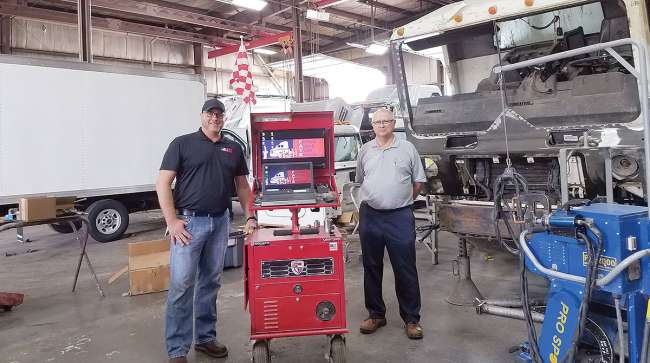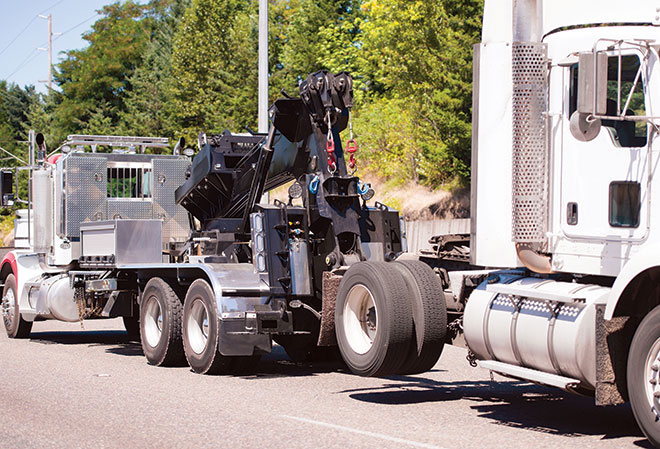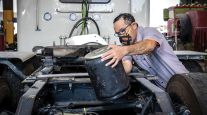The Complexities of Truck Collision Repair

Heavy-duty collision repair is becoming increasingly complex due to a variety of factors, including the conversion from steel to aluminum bodies, the changing componentry and design of trucks and the proliferation of onboard sensors.
This added complexity is causing more fleets to consider outsourcing this type of specialized work, industry experts said.
“It’s almost like repair shops have to be not only experts in repair, but in finding the repair information, depending on the year, make and model of the truck,” said Joey Fassett, general manager at Al’s Automotive and Truck Service Center in Exeter, N.H.
On a typical day when a collision job rolls in, Fassett’s team does an inspection to identify all parts that may have been impacted. “Then we find out what pieces have to be replaced, what work must be done, and everything that goes into it for the insurance estimate,” he said.
As Fassett’s team identifies the components, they also plan how to put them back together. “We have to follow all the specs required to make the truck roadworthy again so that everyone is safe,” he said.
“Those specs are whatever research and due diligence repair shops do to ensure they’re addressing the right systems, using the right parts and materials, and following procedures in a way that conform to the initial integrity required of each component,” Fassett said.

A wrecker hooks to a broken-down truck on a highway. (Getty Images)
Jim Kolea, president of PennFleet Corp., a collision-repair company in Boothwyn, Pa., cites an example highlighting the importance of accurate repair.
“Think about all of the sensors in a truck with crash-avoidance technology,” he said. “If any of those sensors are out of alignment by even one degree, it could cause an accident.”
As for one large fleet, PepsiCo Inc. “does not own a body shop,” said Lee Kirby, senior fleet manager at the White Plains, N.Y.-based private fleet operator. “All of our equipment that has body damage is outsourced, and we have many shops we use at different locations we handle.”
PepsiCo has about 20,000 heavy-duty trucks, Kirby said. “The big item we look for in collision repair is turnaround time or the amount of down time. Other than that, we are agnostic on how repairs get made.”
Kolea compares the technology in heavy-duty trucks today to that in personal computers. “It’s changing almost overnight, but no one is writing repair procedures. We need to make sure procedures are out there.”
To that end, Robert Braswell, executive director of American Trucking Associations’ Technology & Maintenance Council, said two new TMC task forces have formed to address the issue.
“One will deal with turning the wrenches — creating guidelines and best practices to improve safety, quality and reliability of service,” Braswell said.
The other group will develop “a road map of steps in the business process, showing what a customer should expect from the beginning to the end of the repair,” he said.
One maintenance director thinks the guidelines are needed.
“Most manufacturers have gone to composite plastic or fiberglass hoods, and the adhesives are different for each one,” said Kevin Adriaansen, director of maintenance for Leonard’s Express, a Farmington, N.Y.-based national truckload carrier with about 300 heavy-duty company trucks, and Johnson Equipment Sales and Service Inc., a sister company.
“Aluminum is another challenge,” he said. “Some can be straightened, but you have to watch how you heat it to straighten it. If a panel is compromised too much, you have to replace it.”
Mike Adler, fleet manager for Colerain Township, Ohio, said his fleet sends all of its body work out.
“We have enough problems getting all the mechanical done,” he said.
Colerain has 14 specialized heavy-duty vehicles in its fire department alone, including ladder trucks, pumpers, tankers and a decontamination unit.
“All of our fire apparatus is made of aluminum, and that takes special knowledge to repair,” Adler said. “Aluminum is not only lighter and lasts longer than steel, it behaves differently,” he said, noting that aluminum corrodes rather than rusts and has different bonding properties than steel so the repair protocols are different.
“If you’re bolting on a light with steel screws, for instance, the screws should be stainless steel because stainless doesn’t rust,” Adler said, adding that the screws must be coated with a sealant to maintain the bond. “Welding on aluminum is different from welding on steel, too. You have to be certified to weld on aluminum ladder trucks, and you have to be recertified every year.”
Adler used to take collision-repair jobs to a nearby truck dealership. “But they didn’t know how to do aluminum,” he said. He subsequently visited several local repair shops, talking to shop owners and examining the work being done.
When a light-duty pickup truck ran into a Colerain firehouse in June 2013 and hit a pumper truck so hard that it moved the vehicle three feet and caused $30,000 in damage, Adler had it towed to a shop that he now works with regularly. “This shop is second to none, and that truck was still out almost two months,” he said.
Meanwhile, Johnson Equipment currently performs repairs on Leonard’s Express trucks involved in collisions less than 500 miles from Farmington. Work on trucks involved in more distant crashes is outsourced to shops in those areas.
Now, however, Johnson Equipment is building a collision repair shop at Leonard’s Express. The new shop will house a paint booth and frame-straightening equipment, and employ up to six repair professionals. Adriaansen of Leonard’s Express said, “It’s being built to keep as much of the Leonard’s Express collision work in-house as possible, to turn the equipment around quicker and help control costs at the same time.”
“With the addition of this shop, we’ll be able to do virtually all our repairs in-house,” he said.
Johnson Equipment also does collision work for other fleets, and Adriaansen sees the trend increasing.
“If you’re not going to do collision repairs internally, you need to partner with someone who’ll help you,” he said. “More fleets, especially larger ones, are doing this so they can get their equipment back on the road faster and mitigate some costs internally.”
So quickly are the components and design of heavy-duty trucks changing that Chris Sterwerf, chief finance and operations officer at Fairfield Auto and Truck Service in Fairfield, Ohio, said large body shops are starting to employ full-time research-and-repair planners.
“Traditionally, shops had one technician to handle a truck from beginning to end,” said Sterwerf. “But now the work is so sophisticated that you need an expert to disassemble and a repair planner to watch and work alongside with a computer, looking up repair information.”
“Then the truck is passed on to a structure technician, then to the body department, then to refinishing, and then back to assembly to be put back together,” Sterwerf said, adding that ideally, the person who disassembled also performs the reassembly.
Repair information can be hard to find, Sterwerf said. This is partly because manufacturers aren’t required to share it and partly because when the information is accessible, “it may be a lot of mechanical information but very little about collision repair.”
Ted Burke, president of Dennis K. Burke Inc., a Taunton, Mass.-based fuel distributor, said his company outsources all collision and body work to a network of vendors scattered across the eight states on the fleet’s delivery route.
“I think it’s more efficient to have this expertise outside,” said Burke, whose fleet operates 85 heavy-duty trucks. “We don’t have many accidents that require body work, so it’s not economically feasible for us to build up that kind of expertise in-house. We only do maintenance work in our shop.”
Sterwerf said that in his experience, “many fleets and dealerships don’t have body shops or have tried them and can’t sustain them.”
“With the specialized equipment and the cost behind it — a frame machine can cost more than $200,000 and a paint booth can cost upward of $700,000 — you need a volume of work to substantiate those costs,” he said.
Sterwerf also said fleets that do their own collision repair take on a lot of liability that can be diversified by outsourcing the work.
“Because it’s hard to get repair information, you might not repair the vehicle properly, and that can come back to haunt you,” he said.
Peggy Liao, a spokeswoman for Decisiv, which develops software for the commercial vehicle market, believes fleets could benefit significantly from systems that streamline communication and collaboration between fleets and service providers.
“By giving everyone in the service process visibility from beginning to end, you give all parties valuable information about how trucks behave and how to repair them, and you save time and money in the long run,” she said.
Liao said Decisiv’s platform integrates with truck management systems to pull up a truck’s service history, warranties, repair notes and manufacturer details and put them all in one place.
“And if a truck is broken down on the highway, the platform can gather the truck’s history and telematics information that’s entered into the system and tell you which dealers are nearby with availability of space, parts and technicians,” she said.
Meanwhile, TMC’s task forces are starting their work. Sterwerf chairs the HD Collision Repair Guidelines task force.
“The goal is to improve safety for the driver, fellow motorists and technicians,” he said. “The more we have in black and white, the better.”
Fassett of Al’s Automotive and Truck Service Center chairs the HD Collision Repair Roadmap task force. Kolea of PennFleet Corp. is a member of both.



